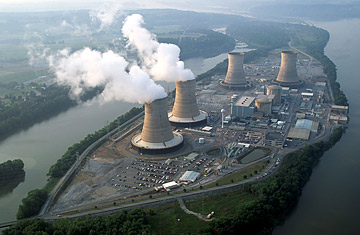
Three Mile Island Nuclear Power Plant
(4 of 11)
Not until 6 a.m., said Curry, did workers notice that "a small amount" of radioactive water had leaked onto the floor of the containment building. That meant the primary loop, which brings cooling water into direct contact with the radioactive reactor core and keeps its temperature at a safe 600° F., had been affected in some unexplained way. Curry insisted that an emergency was declared almost immediately and the proper state and local authorities promptly notified. State police immediately blocked off the two bridges leading to the 600-acre island, letting through only plant officials.
The company then issued a statement that was intended to head off public concern. "There have been no recordings of any significant levels of radiation and none are expected outside the plant," it said. "The reactor is being cooled according to design by the reactor cooling system, and should be cooled by the end of the day. There is no danger of a meltdown. There were no injuries, either to plant workers or to the public." Declared Curry: "Everything worked. The shutdown was automatic." Added David Klucsick, another company spokesman: "We are not in a China Syndrome situation."
Shortly after the company released its soothing statement, officials of Pennsylvania's department of environmental resources flew over the plant in a helicopter, carrying a Geiger counter. They reported detecting "a small release of radiation into the environment."
How had that happened? Curry and other company spokesmen began to backpedal and offered a new explanation. When the secondary loop lost pressure and the turbine stopped, they said, this caused a rise in both pressure and temperature in the primary loop. This, in turn, automatically opened several relief valves, letting some contaminated water leak onto the floor of the reactor building. Just "a small amount"? Well, no, conceded a company engineer. It was 50,000 gal. of water, and it accidentally overflowed the drainage tanks, covering the floor to a depth of "several feet." Later an NRC official said the leak was 250,000 gal.
How had the radioactive steam escaped from the reactor building? Again, said the company spokesmen, this was intentional. The control rods had automatically dropped into the core and stopped the chain reaction. But the loss of water in the primary loop allowed the reactor to get too hot. When more water was pumped into the system, the pressure rose —and other relief valves opened. These valves vented some of the radioactive steam out of the top of the dome. When the core temperature continued to rise, employees deliberately vented more steam in brief bursts. Some of the spilled radioactive water from the primary loop was automatically drawn from the containment dome's floor into the neighboring pump-house building, which does not normally handle radioactive material and is not radiation-safe. The water gave off radioactive xenon and krypton gases that escaped through the plant's ventilation system into the atmosphere.
How much radioactivity leaked?
